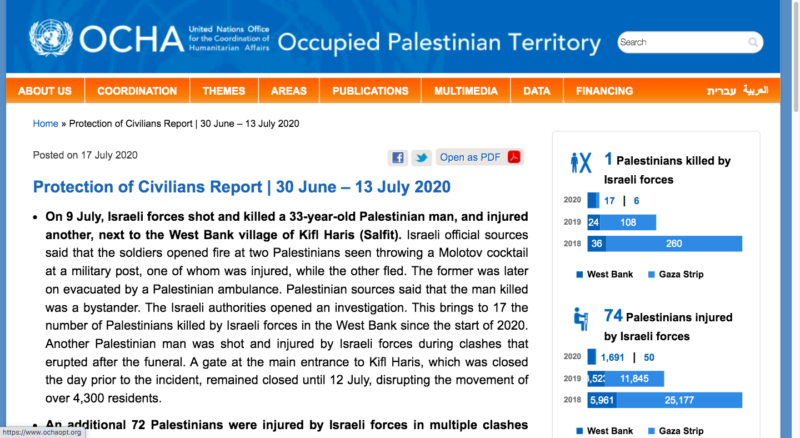The United Nations Office for the Coordination of Humanitarian Affairs (OCHA) – Occupied Palestinian Territory (June 30 – Jul 13, 2020)
Biweekly Highlights
- On 9 July, Israeli forces shot and killed a 33-year-old Palestinian man, and injured another, next to the West Bank village of Kifl Haris (Salfit). Israeli official sources said that the soldiers opened fire at two Palestinians allegedly seen throwing a Molotov cocktail at a military post, one of whom was injured, while the other fled. The former was later on evacuated by a Palestinian ambulance. Palestinian sources said that the man killed was a bystander. The Israeli authorities claimed to have opened an investigation into the matter. This brings the number of Palestinians killed by Israeli forces in the West Bank since the start of 2020, to 17. Another Palestinian man was shot and injured by Israeli forces during confrontations that erupted after the funeral. A gate at the main entrance to Kifl Haris, which was closed the day prior to the incident, remained closed until 12 July, disrupting the movement of more than 4,300 residents.
- An additional 72 Palestinians were injured by Israeli forces in multiple confrontations across the West Bank. Forty of these injuries occurred during search and arrest operations in Abu Dis town (Jerusalem), the East Jerusalem neighbourhood of Al-‘Isawiya and Nablus city. Overall, there were 150 such operations across the West Bank, 30% of which were in East Jerusalem and its surroundings. Another 30 injuries were recorded during various protests against settler-related activities, in ‘Asira ash Shamaliya (Nablus), following the establishment of a new settlement outpost nearby; in Biddya (Salfit) protesting continued attacks on farmers (see below); and in Kufur Qaddoum (Qalqilia), against the longstanding access restrictions and settlement expansion in the area. One Palestinian was injured during a protest against Israel’s annexation plan in Hebron city, and another at a Barrier checkpoint in the Tulkarem governorate. Three of the injuries were by live rounds while the rest were due to tear gas inhalation, rubber coated steel rounds and physical assault.
- One of the main military roadblocks controlling access to the restricted area of Hebron city was closed for several hours almost every day during the period, disrupting the access of Palestinians to basic services in other parts of the city. The closures were implemented during and after almost daily anti-annexation protests and clashes, taking place near the roadblock (outside the restricted area). These restrictions have exacerbated the coercive environment imposed on the over 1,000 Palestinians living in this area of Hebron city, where illegal Israeli settlement compounds have been established.
- On 5 July, Israel claimed that a Palestinian armed group fired three rockets towards southern Israel, following which Israeli forces attacked an armed group’s position and several open areas in Gaza. None of the attacks resulted in human casualties, while three Palestinian houses and a farm were damaged by Israeli air strikes.
- On at least 18 occasions, Israeli forces opened warning fire near Israel’s perimeter fence around Gaza, and off the coast of the Mediterranean sea, presumably to enforce access restrictions. While no casualties were reported, in one incident, Israeli naval forces arrested four fishermen and confiscated two boats; the fishermen were later released. Also, in two incidents, Israeli forces arrested two Palestinians while they were attempting to enter Israel, one through the fence and, the other, from the sea. On three occasions, Israeli forces committed limited incursions into the besieged Gaza Strip, and carried out land-levelling and excavation operations near the fence.
- Thirty-one Palestinian-owned structures were demolished or seized for the lack of Israeli-issued building permits, displacing 13 people and affecting the livelihoods of more than 100 others. In the Palestinian Bedouin community of Fasayil, in the Jordan Valley, the Israeli authorities demolished 12 homes and livelihood structures used on a seasonal basis. Another four targeted structures were located in four Bedouin communities within, or next to an area allocated for the expansion of the of the Ma’ale Adumim settlement (the E1 Plan). Two structures in the At Taybeh community (Hebron), also in Area C, were demolished on the basis of Military Order 1797, providing for the expedited removal of unlicensed structures deemed as “new”. Nine structures were demolished in East Jerusalem, including two in Al ‘Isawiya neighbourhood, where on 19 February 2020, the Jerusalem municipality announced a six-month freeze in demolitions.
- Israeli forces bulldozed agricultural land in of the Hebron governorate, in two locations, in Area C, in which Israel claims full military and civil control, claiming the area was designated as “state land”. In Al Baq’a, near Hebron city, four dunams of seasonal crops and a retaining wall were bulldozed and destroyed, while next to Sa’ir town, 70 olive trees were uprooted.
- Five Palestinians were injured, dozens of trees burned, and uprooted, while vehicles were vandalized by Israeli settlers. All the injuries occurred in two incidents in Biddya village (Salfit), when settlers attacked farmers working their land: three were shot with live ammunition, one was physically assaulted, and another bitten by a dog that was unleashed by settlers. Dozens of olive trees were set on fire in Burin village (Nablus) and a few others were uprooted in the As Seefer community (Hebron), located in the closed area behind the Barrier. Israeli settlers also raided Al Lubban ash Sharqiya village (Nablus) where they vandalized 12 vehicles.
- According to an Israeli NGO, four Israelis, including a child, were injured after being hit with stones while traveling on various West Bank roads; a total of 19 Israeli-plated vehicles reportedly sustained damage as a result of stones, and one by a Molotov cocktail, thrown by Palestinians.
See the full report here.

